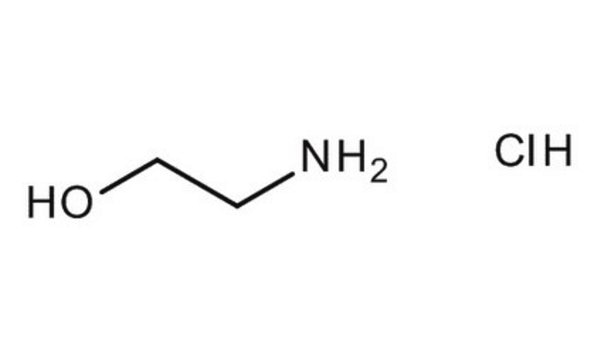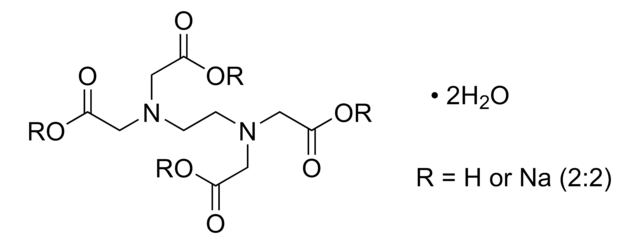RDD028
Ethanolamine hydrochloride
anhydrous, free-flowing, Redi-Dri™, ≥99.0%
Synonym(s):
Colamine hydrochloride, Ethanolamine chloride, 2-Aminoethanol hydrochloride
Sign Into View Organizational & Contract Pricing
All Photos(2)
About This Item
Linear Formula:
H2NCH2CH2OH · HCl
CAS Number:
Molecular Weight:
97.54
Beilstein/REAXYS Number:
3542892
MDL number:
UNSPSC Code:
12352116
NACRES:
NA.21
Recommended Products
grade
anhydrous
Quality Level
product line
Redi-Dri™
assay
≥99.0%
quality
free-flowing
pKa (25 °C)
9.5
mp
82-84 °C (lit.)
SMILES string
NCCO.[H]Cl
InChI
1S/C2H7NO.ClH/c3-1-2-4;/h4H,1-3H2;1H
InChI key
PMUNIMVZCACZBB-UHFFFAOYSA-N
Looking for similar products? Visit Product Comparison Guide
General description
Ethanolamine hydrochloride, a versatile compound in biochemistry and molecular biology, plays a pivotal role in diverse research areas. Primarily, it functions as a buffering agent, ensuring a stable pH environment crucial for enzymatic reactions, protein solubilization, and other biological processes. Its significance extends to membrane protein studies, aiding in the extraction of these proteins from cell membranes. It also finds utility in cell culture and as a reagent for biological sample preparation, simplifying nucleic acid and protein isolation, as well as facilitating the detection of proteins by western blotting and immunohistochemistry. This compound′s wide-ranging applications make it indispensable in biochemical research, contributing to various experimental procedures and advancing our understanding in fields such as molecular biology, immunology, and cellular biology.
Application
Redi-Dri™ is an innovative packaging product line that helps eliminate clumping material by adding extra packaging process steps without any chemical additives, anti-clumping agents, or hydrophobic compounds. Redi-Dri™ offers a more convenient and safer way to handle the products.
Ethanolamine hydrochloride has been used:
- in overnight incubation of the tips to attach primary amine groups at the tip surface
- in the preparation of DMEM (dulbecco′s modified eagle′s medium)/F-12 media to culture human epidermal growth factor receptor 2 (HER2) cells derived from MMTV-HER2 transgenic mouse mammary tumors
- to administer the cultures to study its effect on the endogenous phosphatidyl ethanolamine pool and autophagy process
Biochem/physiol Actions
Ethanolamine hydrochloride is utilized as a carbon and nitrogen source by bacteria that differs phylogenetically. It exists as phosphotidylethanolamine in the bacterial and mammalian cell membrane. Ethanolamine-ammonia lyase is responsible for the degradation of ethanolamine into acetaldehyde and ammonia. Ethanolamine is known to positively support lipid accumulation in photosynthetic organism model.
Features and Benefits
- Suitable for molecular biology
- Redi-Dri packaging controls moisture for hygroscopic chemicals that commonly clump
- Powder remains free-flowing and easy to use
- Safer to handle and weigh out for routine use in the lab
- Eliminates clumps, maintaining product moisture, quality, and product specifications
Other Notes
For additional information on our range of Biochemicals, please complete this form.
Legal Information
Redi-Dri is a trademark of Sigma-Aldrich Co. LLC
comparable product
Product No.
Description
Pricing
wgk_germany
WGK 1
flash_point_f
Not applicable
flash_point_c
Not applicable
Choose from one of the most recent versions:
Certificates of Analysis (COA)
Lot/Batch Number
Sorry, we don't have COAs for this product available online at this time.
If you need assistance, please contact Customer Support.
Already Own This Product?
Find documentation for the products that you have recently purchased in the Document Library.
K C Andree et al.
Lab on a chip, 19(6), 1006-1012 (2019-02-15)
The load of circulating tumor cells (CTC) is related to poor outcomes in cancer patients. A sufficient number of these cells would enable a full characterization of the cancer. An approach to probe larger blood volumes, allowing for the detection
Foodborne Diseases: New Insights for the Healthcare Professional, 14-14 (2012)
Selective cyclin-dependent kinase 2/cyclin A antagonists that differ from ATP site inhibitors block tumor growth
Mendoza N, et al.
Cancer Research, 63(5), 1020-1024 (2003)
Amino Alcohols-Advances in Research and Application, 29-29 (2013)
Unbinding molecular recognition force maps of localized single receptor molecules by atomic force microscopy
Sotres J, et al.
ChemPhysChem, 9(4), 590-599 (2008)
Our team of scientists has experience in all areas of research including Life Science, Material Science, Chemical Synthesis, Chromatography, Analytical and many others.
Contact Technical Service



